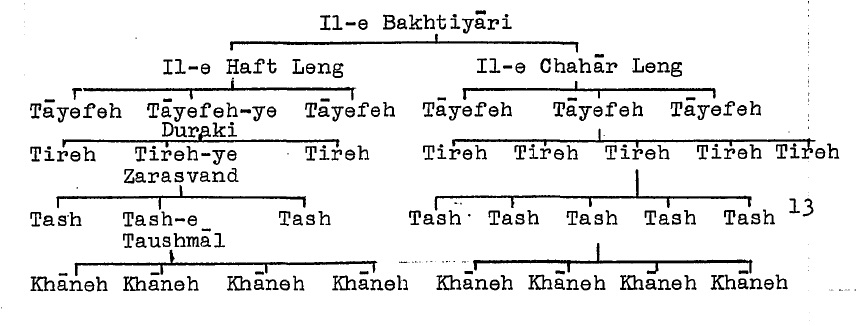The political grouping of the tribes below the Haft Leng and the Chahar Leng have been in a continuous state of change. Briefly, Barth writes,
A “tribe” among South Persian nomads is a political concept; its unity is not ethnic, but depends on its allegiance to a chief. The processes whereby ethnic complexity persists in the tribes, and whereby rapid changes in their relative and absolute sizes takes place, can now be . . . understood. Any imbalance between tribes in the effectiveness of centralized authority stimulates an extension of the stronger centre’s claims to authority, and a voluntary flow of commoners from the weaker to the stronger center.
A brief digression must be made to summarize Bakhtiyari tribal divisions to identify them and their function. The terminology used in sources written by the Bakhtiyari khans to describe the various levels of the Bakhtiyari hierarchical political structure is not consistent and possibly differs from oral usage among the Bakhtiyari tribesmen themselves.
The term il (Turkish and Persian, tribe) is used in referring to the entire Bakhtiyari confederation as well as to the two major subdivisions of the Haft and Chahar Leng. From the last quarter of the nineteenth century until 1934 the leader of the Il-e Bakhtiyari was the ilkhan (Turkish and Persian, paramount tribal chief) and his “lieutenant” was the ilbeg. Previous to this there had been only a few periods in which a single khan was able to assert his authority over most of the confederation, win some outside support, and hence receive some recognition from the Iranian government as representative of the Bakhtiyari. The Turkish Qajar and Qashqa’i confederations have had an older tradition of unitary rule under an ilkhan, either appointed or elected, than have the Bakhtiyari.
At the next level, that of the Haft Leng and Chahar Leng, there has not been, at least since the eighteenth century, a single leader or political head who ruled or represented all of either of these two major divisions, although a khan of one of the subtribes might be dominant over one of these divisions for a short period. Traditionally the Haft Leng and the Chahar Leng each consisted of four sub-tribes called tayefeh (Arabic or Persian, family, tribe, or clan), or sho’beh (Arabic and Persian, branch or division), or tireh (Persian, sect or division). For example, the Tayefeh-ye Duraki is one of the four major subdivisions of the Haft Leng. The Duraki khans, or the khans from this tayefeh level, are actually khans of the subtribes making up the next division which are also called tireh as well as ashireh (Arabic and Persian, tribe or family). The position of khan as political leader will be discussed in greater detail below; in his absence, however, his appointed representative is the kalantar or the kadkhoda. (According to one recent account, 12 the khan*s representative of the tayefeh is the kalantar and the representative of the tireh, the kadkhoda, but the written sources do not distinguish between kalantar and kadkhoda as leaders of either of these two levels.) For example, a Duraki khan is “khan-e Taushmal-e Zarasvand-e Duraki-ye Haft Leng-e Bakhtiyari”; he is a khan from the Taushmal tash (Bakhtiyari, hearth or fire and here means family) of the tireh of the Zarasvand of the tayefeh of the Duraki of the il of the Haft Leng and Bakhtiyari. Thus the tireh is further subdivided into tash, which is a camping unit consisting of ten to twenty tents or households, and, if there is no khan or kalantar/kadkhoda present, the decision makers at this level are the rish safid (white beards or elders). (These named divisions of the Bakhtiyari socio-political system may be diagramed as follows on page 65.)
Lastly, the basic unit of Bakhtiyari society is the nuclear or elementary family, famil or khanevadeh; among the Bakhtiyari their number is counted by khaneh or chador (Persian, house and tent). This independent household consists of a man, his wife, and children, and in a few cases a widowed parent and/or -unmarried brothers and sisters.
Five is the usual figure given for the number of occupants in a tent, but Mrs. Bishop estimated the occupancy to be eight.^ This family forms the unit of production and consumption, and the male head represents his tent in dealing with the other tents in his tash in matters relating to the migration, pastures, and camp sites. Grazing requirements of the flocks in the drier environment of the garmsir do not permit the grouping together of an entire tribe or subtribe, but rather require small and scattered clusters of tents which cooperate in herding. In the yailaq, with higher quality pastures and more abundant water, the camping/herding units are closer together.

